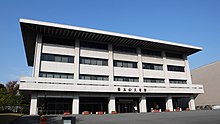National Archives of Japan

The Japanese National Archives ( Japanese 国立 公文書館 , Kokuritsu Kōbunsho-kan , English National Archives of Japan ) has the usual function of evaluating, classifying, processing government documents that have been handed over for permanent storage. The stored materials can be viewed and holdings are regularly shown in exhibitions. Total stock 545,000 volumes.
History of origin
In Japan, laws were first passed in the Meiji period that established the archives of the respective ministries. After the Second World War , when research into recent history in particular became an urgent task, it became necessary to collect the scattered documents or to reconstruct those that had been lost. So it happened that in November 1959 the Japanese Science Council ( Nihon gakujutsu kaigi ) made a proposal to the Prime Minister to set up a national archive.
On the other hand, since the 7th year (1874) of the Meiji government, an archive of the top government has existed, which, together with the establishment of a cabinet of ministers, became the archive of cabinets in 1886. Japanese and Chinese classics as well as old documents were also kept there and made accessible for research (see below). These holdings actually belonged in a library, but were taken over by the latter after the National Archives were established. This gives the National Archives its special color compared to foreign institutions.
On March 31, 1971, the necessary changes to the Prime Minister's Office Act were amended and the National Archive was declared an Office of the Office. The law came into force on July 1st of the same year. The transfer of government documents, their storage and disclosure is carried out on the basis of agreements with liaison committees in the individual ministers and offices. In principle, the stored materials are disclosed 30 years after their creation.
The collection
The main government documents that are retained are:
- Materials on the old and new constitution.
- Meiji government materials up to the establishment of parliament from October Keio 3 to Meiji 14 (1881)
- Archival materials of the Meiji government from 1868 to 1886; d. H. up to the parliament constitution
- Materials from Meiji 15 (1882) in continuation of the collection under (2)
- Various materials from Meiji 19 (1886)
- Other (materials from the Council of Elders since 1893, appointments, dismissals since 1871, decrees under the Ministry of the Interior since 1902, documents for the establishment and dissolution of schools since 1884, documents on the railway system since 1889, documents on the establishment and management of national parks since 1927)
The following important holdings are kept from the collection of the cabinet library:
- Holdings from before 1868, such as those of the shogunate government,
- Holdings of the Momijiyama Library ( 紅葉 山 文庫 ),
- Holdings of the Shōheizaka office ( 昌平 坂 学問 所 ),
- Holdings of the place of study for ancient Japanese literature ( 和 学 講 談 所 ),
- Holdings of the Medical Office ( 医学 間 ),
- Holdings from the Tōdai Temple ( 東大寺 ) and the Daijōin ( 大乗 院 ) (both in Nara) and the Kōyasan ( 高 野山 ),
- Holdings of the Ninagawa ( 蜷 川 ) and the Kutsuki ( 朽木 ) families,
- Holdings of the princely families Oshikōji ( 押 小路 ), Hirohashi ( 広 橋 ), Bōjō ( 坊 城 ), Madenokōji ( 万里 小路 ), Kanroji ( 甘露寺 ), Nakamikado ( 中 御 門 ), Yamashina ( 山 科 ),
- Bakufu diaries and legal collections, the western materials consulted by the Meiji government and their translations, as well as government publications.
The archive has made the collection of the cabinet accessible through a series of catalogs. Facsimile editions have also been made of a number of works. These include around 30 collections that have been declared an important cultural asset .
The National Archives are located in Tokyo in a building (4 floors above ground, 2 floors below ground) on the northern part of the former Shogun residence.
literature
- 国立 公文 書館 (overview, 32 pages), 2000
- National Archives of Japan (overview, 32 pages), 2000
Web links
- National Archives website (Japanese, English)
Coordinates: 35 ° 41 ′ 24.9 ″ N , 139 ° 45 ′ 14 ″ E